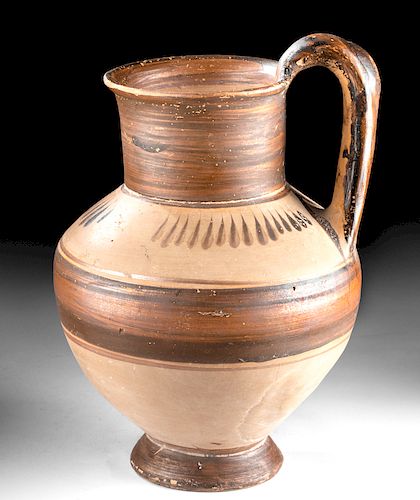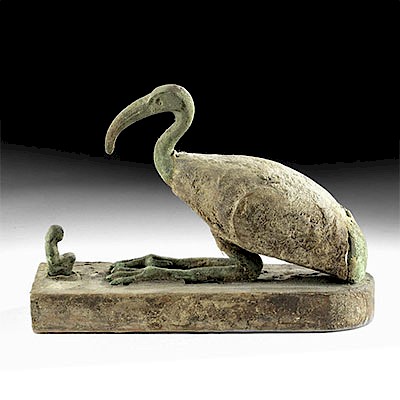South Italic Messapian Pottery Oinochoe
Lot 33
About Seller
Artemis Fine Arts
686 S Taylor Ave, Ste 106
Louisville, CO 80027
United States
Selling antiquities, ancient and ethnographic art online since 1993, Artemis Gallery specializes in Classical Antiquities (Egyptian, Greek, Roman, Near Eastern), Asian, Pre-Columbian, African / Tribal / Oceanographic art. Our extensive inventory includes pottery, stone, metal, wood, glass and textil...Read more
Estimate:
$900 - $1,200
Absentee vs Live bid
Two ways to bid:
- Leave a max absentee bid and the platform will bid on your behalf up to your maximum bid during the live auction.
- Bid live during the auction and your bids will be submitted real-time to the auctioneer.
Bid Increments
| Price | Bid Increment |
|---|---|
| $0 | $25 |
| $300 | $50 |
| $1,000 | $100 |
| $2,000 | $250 |
| $5,000 | $500 |
| $10,000 | $1,000 |
| $20,000 | $2,500 |
| $50,000 | $5,000 |
| $100,000 | $10,000 |
| $200,000 | $20,000 |
About Auction
By Artemis Fine Arts
Oct 31, 2019
Set Reminder
2019-10-31 10:00:00
2019-10-31 10:00:00
America/New_York
Bidsquare
Bidsquare : Fine Antiquities, Asian, Ethnographic Art
https://www.bidsquare.com/auctions/artemis-gallery/fine-antiquities-asian-ethnographic-art-4581
Our Halloween Day auction features classical antiquities, ancient and ethnographic art from cultures encompassing the globe, plus fine art. Artemis Fine Arts info@artemisgallery.com
Our Halloween Day auction features classical antiquities, ancient and ethnographic art from cultures encompassing the globe, plus fine art. Artemis Fine Arts info@artemisgallery.com
- Lot Description
Magna Graecia, South Italic, Messapian, ca. 5th century BCE. An ample bi-chrome pottery vessel with an inverted piriform body, a tubular neck rising to a gently flared rim, and a single handle joining rim to shoulder, all upon a raised foot. The vessel body is beautifully decorated with a register of abstract leaves arranged in three bands on the shoulder and red striated bands of varying widths. Neck, rim, and foot are also embellished with red and black hues to complement the cream ground. This beautiful oinochoe was most likely coveted for both its design as well as its functionality. Size: 5.875" in diameter x 8.875" H (14.9 cm x 22.5 cm)
Beazley identified ten types of oinochoe - all of which are taller than they are wide and possess a single handle - the various types distinguished by variations on the profiles, mouth types, and handle forms. Although the Messapian people were influenced by Greek colonists in other parts of southern Italy, they had a distinctive culture that included burial practices unique unto their own. Unlike the Greeks in Apulia, Messapians reused their tombs for several burials, most likely from the same family. Whenever a tomb was reused, the earlier grave goods were removed, along with the body, and then reburied inside or outside the same tomb.
Provenance: private New York, New York, USA collection; ex-collection Professor Dr. Gunther Marschall, Hamburg (1913-1997), acquired between 1967 and 1975
All items legal to buy/sell under U.S. Statute covering cultural patrimony Code 2600, CHAPTER 14, and are guaranteed to be as described or your money back.
A Certificate of Authenticity will accompany all winning bids.
We ship worldwide and handle all shipping in-house for your convenience.
#149187Area of repair/restoration on lower body beneath the handle. A few chips to the shoulder. Expected surface wear with scuffs and nicks here and there. The black glaze is red in places due to ancient misfiring in the kiln. Areas have developed a silvery iridescence over time. Nice mineral deposits grace the surface as well.Condition
- Shipping Info
-
All shipping is handled in-house for your convenience. Your invoice from Artemis Gallery will include shipping calculation instructions. If in doubt, please inquire BEFORE bidding for estimated shipping costs for individual items.
-
- Buyer's Premium



 EUR
EUR CAD
CAD AUD
AUD GBP
GBP MXN
MXN HKD
HKD CNY
CNY MYR
MYR SEK
SEK SGD
SGD CHF
CHF THB
THB
















